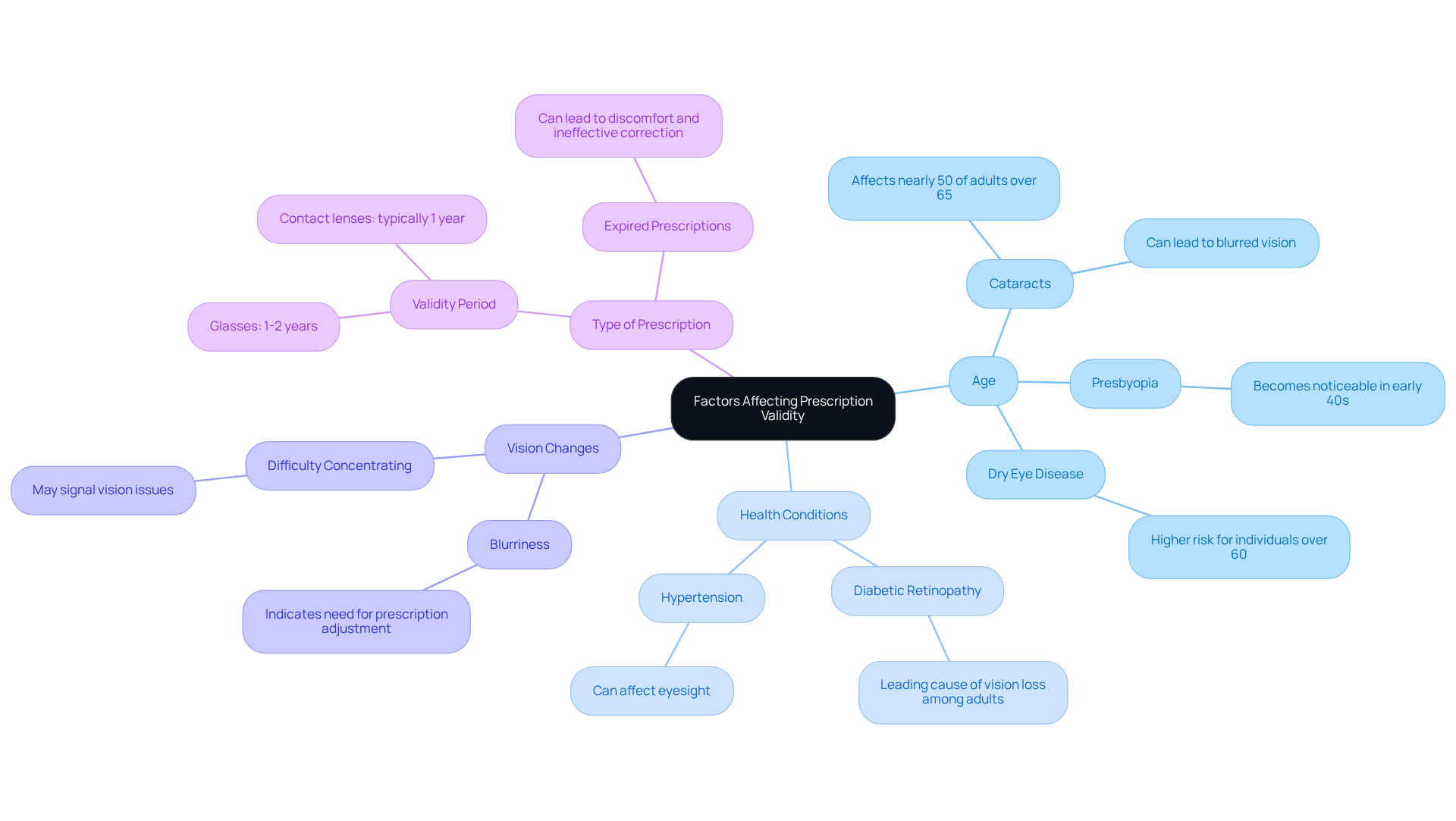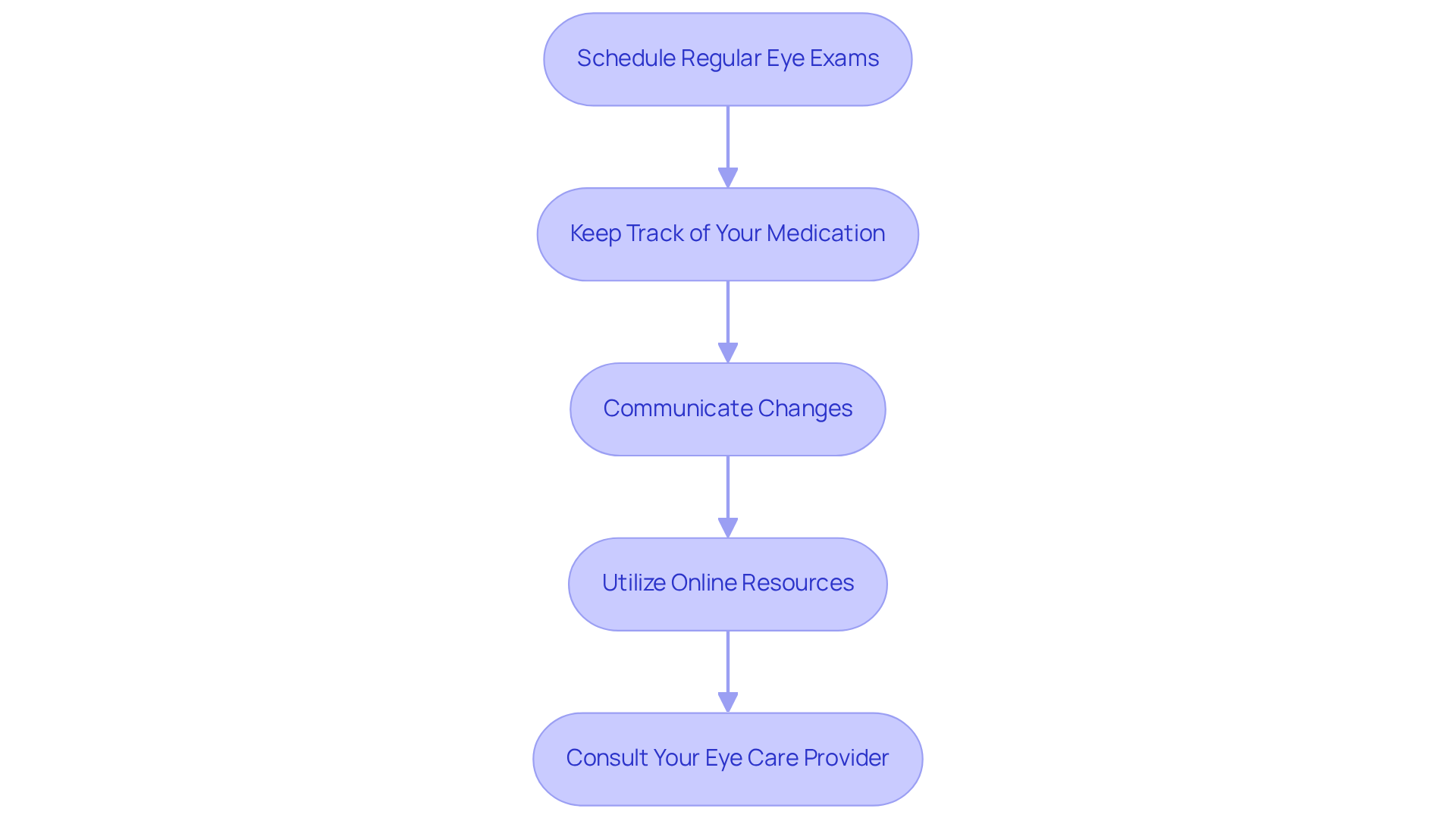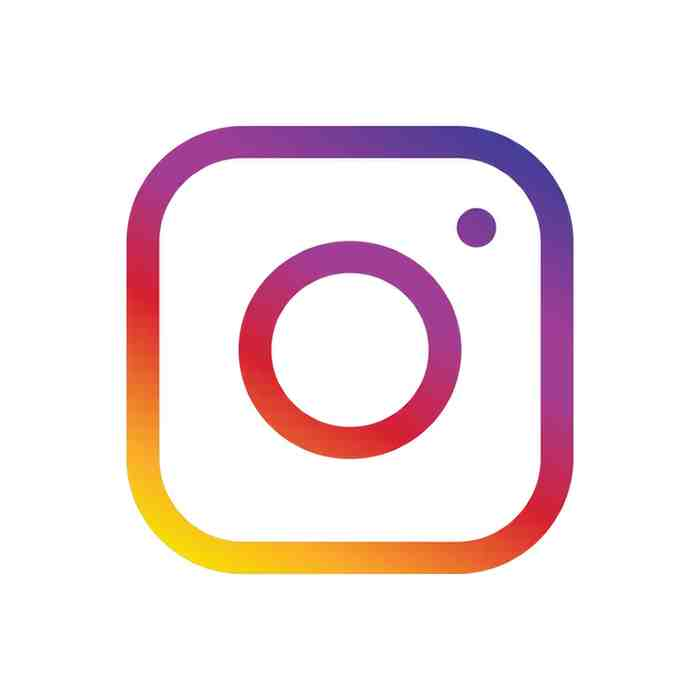Posted by: Northwest Eye in General on November 24, 2025
Introduction
Understanding the nuances of an eye prescription is crucial for maintaining optimal vision and eye health. We understand that many individuals may feel overwhelmed by the technical jargon and the significance of each component. However, grasping these details empowers you to engage effectively with your eye care providers.
A pressing question often arises: how long is an eye prescription valid, and what factors influence its expiration? It’s common to feel uncertain about these aspects. Exploring these insights can lead to better eye care practices, ensuring that your vision remains clear and accurate. We are here to help you through this process.
Understand Your Eye Prescription Basics
An eye assessment is a vital document from your eye care professional, outlining the specific type and strength of lenses needed to correct your vision. It usually includes measurements for both eyes, indicating conditions like nearsightedness (myopia), farsightedness (hyperopia), or astigmatism. We understand that grasping these elements is essential for appreciating the importance of maintaining your medication order and knowing when to seek updates.
Key components of an eye prescription include:
- Sphere (SPH): This indicates the lens power needed for correcting nearsightedness or farsightedness.
- Cylinder (CYL): This measures the degree of astigmatism, if present.
- Axis: This specifies the orientation for astigmatism correction.
- Pupillary Distance (PD): This is the distance between your pupils, essential for proper lens alignment.
It’s common to feel a bit overwhelmed by these terms; studies show that many patients aren’t fully acquainted with these essential elements. By familiarizing yourself with them, you empower yourself to engage more effectively with your eye care provider. As one eye care expert observed, “Comprehending your order is the first step in taking control of your eye health.” Practical instances demonstrate that patients who proactively discuss their medications with experts often achieve better results and greater satisfaction with their eye correction.
As presbyopia typically begins around age 40, more regular assessments become necessary. This makes it crucial for patients to keep their eyewear specifications up to date. Remember, how long an eye prescription is good for usually ranges from one to two years after being issued, highlighting the importance of timely updates for preserving optimal sight and overall eye wellness. We are here to help you through this process.

Identify Key Elements of Your Prescription
To effectively manage your eye health, we understand that it’s essential to identify and grasp the key elements of your prescription:
-
Sphere (SPH): This number indicates the lens power needed for vision correction. A negative sign (-) denotes nearsightedness, while a positive sign (+) indicates farsightedness. For instance, a sphere power of -9.00 D signifies significant nearsightedness, requiring stronger corrective lenses.
-
Cylinder (CYL): If present, this number indicates the amount of astigmatism correction needed. It can also have a negative or positive sign, reflecting the curvature of the cornea. Understanding the CYL value helps you recognize how it relates to your visual clarity.
-
Axis: This number, ranging from 1 to 180, describes the orientation of astigmatism correction and is only included if there is a CYL value. It specifies how the lens should be positioned to correct astigmatism effectively.
-
Pupillary Distance (PD): This measurement is crucial for ensuring that the optical center of the lenses aligns with your pupils, maximizing visual clarity and comfort. Accurate PD measurement is vital for the effectiveness of corrective eyewear.
By comprehending these components, you can feel confident that any new glasses or contacts you request will meet your specific sight needs. We encourage you to have regular consultations with your eye care specialist, as this can further enhance your understanding of these components, ensuring optimal eye health and correction. Remember, we are here to help you through this process.

Explore Factors Affecting Prescription Validity
Several factors significantly influence the validity of your eye prescription, and we understand how important this is for your vision:
- Age: As we age, our vision can change more frequently. It’s common for individuals to need regular updates to their prescriptions. For instance, nearly 50% of adults over 65 develop cataracts, which can lead to blurred sight and may require adjustments in their prescriptions.
- Health Conditions: Chronic conditions like diabetes and hypertension can affect your eyesight. Diabetic retinopathy, a complication of diabetes, is a leading cause of vision loss among adults. This highlights the importance of regular eye exams to monitor any changes in your eye health.
- Vision Changes: If you notice symptoms such as blurriness or difficulty concentrating, it might be time to adjust your eyewear. Regular check-ups are crucial for the early detection of issues like glaucoma, which can damage the optic nerve if not treated promptly.
- Type of Prescription: The validity period can differ between various types of medication orders. Typically, how long an eye prescription is good for glasses recommendations is one to two years, while contact lens orders usually last for one year. Understanding these distinctions is essential for maintaining optimal vision.
By acknowledging these factors, you can take proactive steps to manage your eye health effectively. Remember, we are here to help you through this process and ensure you have the right lenses when you need them.

Follow Steps to Manage and Renew Your Prescription
To effectively manage and renew your eye prescription, consider these caring steps:
-
Schedule Regular Eye Exams: We understand that keeping track of your eye health can feel overwhelming. Aim for an eye exam every one to two years, or more often if you notice any changes in your vision. Regular exams are crucial, as they allow eye care professionals to monitor gradual changes before they impact your daily activities. As noted by Cannon EyeCare, “Understanding eyewear updates is fundamental to maintaining optimal visual health.”
-
Keep Track of Your Medication: It’s common to forget about medication expiration dates. Make a note of these dates and set reminders for when it’s time to renew. Approximately 16 states require annual renewals for eyeglass orders, while most states specify how long an eye prescription is good for by mandating a two-year validity period. Research shows that only a small percentage of patients actively monitor their medication expiration dates, which highlights the importance of this practice.
-
Communicate Changes: If you experience any changes in your vision, such as persistent headaches or difficulty discerning fine details, please inform your eye care provider during your next visit. These symptoms often suggest that your current medication may no longer offer sufficient correction. Did you know that approximately 10.7% of adults experience adult myopia progression? This statistic underscores the need for regular updates.
-
Utilize Online Resources: Many eye care providers offer online tools for renewing eyewear orders. Check if your provider has such options available to help streamline the process, making it easier for you.
-
Consult Your Eye Care Provider: If you have questions about your eyewear order or need clarification on any terms, don’t hesitate to ask your eye care professional. As specialists point out, comprehending medication updates is essential for preserving optimal visual well-being.
By following these steps, you can ensure that your vision remains clear and your prescription is always up to date. Remember, we are here to help you through this process, ultimately enhancing your overall eye health.

Conclusion
Understanding the intricacies of an eye prescription is essential for anyone looking to maintain optimal vision and eye health. We understand that navigating this information can feel overwhelming, but it’s important to know that you’re not alone in this journey. The validity of an eye prescription typically ranges from one to two years, depending on various factors such as age, health conditions, and the type of prescription. By staying informed about these aspects, you can ensure you have the right corrective lenses to meet your needs.
Key insights discussed throughout the article highlight the importance of familiarizing yourself with the components of an eye prescription, such as:
- Sphere
- Cylinder
- Axis
- Pupillary distance
Regular eye exams and proactive communication with eye care professionals can significantly enhance your understanding and management of eye health. It’s common to feel uncertain about when to update your prescription, but recognizing the factors that can affect its validity, such as age-related changes and health conditions, underscores the necessity of timely updates.
Ultimately, taking charge of your eye health involves a combination of education, regular check-ups, and open dialogue with your eye care providers. By implementing the steps outlined, you can effectively manage your prescriptions and ensure your vision remains clear and precise. Prioritizing your eye health not only improves your daily life but also contributes to long-term well-being. Remember, we are here to help you through this process, making it imperative to stay informed and proactive in this vital aspect of personal care.
Frequently Asked Questions
What is an eye prescription?
An eye prescription is a document from your eye care professional that outlines the specific type and strength of lenses needed to correct your vision, including measurements for both eyes.
What conditions can an eye prescription indicate?
An eye prescription can indicate conditions such as nearsightedness (myopia), farsightedness (hyperopia), and astigmatism.
What are the key components of an eye prescription?
The key components of an eye prescription include Sphere (SPH), Cylinder (CYL), Axis, and Pupillary Distance (PD).
What does Sphere (SPH) measure in an eye prescription?
Sphere (SPH) indicates the lens power needed for correcting nearsightedness or farsightedness.
What does Cylinder (CYL) measure in an eye prescription?
Cylinder (CYL) measures the degree of astigmatism, if present.
What is the purpose of the Axis in an eye prescription?
The Axis specifies the orientation for astigmatism correction.
Why is Pupillary Distance (PD) important?
Pupillary Distance (PD) is essential for proper lens alignment, ensuring that the lenses are positioned correctly in front of the eyes.
How often should eye assessments be conducted?
Regular assessments become more necessary as presbyopia typically begins around age 40, highlighting the importance of keeping eyewear specifications up to date.
How long is an eye prescription usually valid?
An eye prescription is generally valid for one to two years after being issued.
Why is it important to understand your eye prescription?
Understanding your eye prescription empowers you to engage more effectively with your eye care provider and helps in taking control of your eye health.






